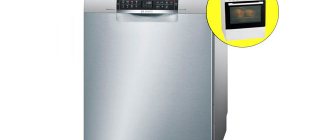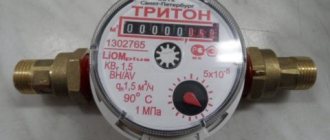When determining what the distance between the refrigerator and the wall should be, most consumers believe that this is not a fundamental issue and is of little importance. Statistics collected from the general experience of manufacturing companies show that the location of a refrigerator plays a huge role in its ability to operate smoothly. Failure to comply with operating rules is the path to rapid failure of the most reliable unit. The work of repairmen who provide warranty repairs to a conventional refrigerator only confirms the existing dependence on the distances to the wall on the side and back.
In the kitchen
Preparing the refrigeration unit for operation
80% of problems with equipment occur due to the fault of owners who ignore the manufacturer’s recommendations.
The first thing a reasonable person does when purchasing a new item is study the instructions. Choosing a location is the second most important task. Even if the room is small, installation of equipment of this type is carried out according to the rules. A flat surface is the first thing you need to prepare . If the floor has defects, adjust the legs of the refrigerator. To prevent slipping, use silicone or plastic stickers. Otherwise, vibration of the unit will lead to premature wear of the equipment.
Temperature compliance
Placement away from heat sources - heating devices, electric and gas stoves. You cannot place the refrigerator near a window. Direct sunlight negatively affects engine performance and disrupts thermoregulation.
Providing a ventilated space. By cooling the refrigerator and freezer compartments, the compressor heats up. The walls of the mechanism need ventilation, which prevents hyperthermia .
Ambient temperature – not lower than +10 °C. At zero, freon thickens and the refrigerator fails.
Long-term operation of the unit also depends on the following factors:
- The humidity level should not exceed 75%. When damp, the metal corrodes and conductivity increases.
- Grounded socket. Failure to comply will result in electric shock and fire.
- Proximity to household appliances is prohibited. Even a coffee maker can affect the operation of the mechanism.
- The use of extension cords or tees is not advisable. Leads to breakdown of the stabilizer, which protects the refrigerator from voltage surges in the network.
- Positioning close to a wall is dangerous for vulnerable components located at the rear of the unit.
- Installing a refrigerator in a residential area is not recommended. The mechanism makes noise - especially undesirable for families with small children.
- Placement next to the sink. Splashes contaminate the surface, create increased humidity, and cause short circuits.
Important! If operating conditions are violated, the owner loses the right to warranty service.
Installation of a built-in refrigerator
The main rule when installing refrigeration equipment is to leave gaps for air circulation. This will help avoid overheating. If the unit is built into a cabinet, there should be gaps of at least a few centimeters on all sides. The cabinet where the built-in refrigerator is located should not be completely closed - take a cabinet with a missing back wall.
There is a shelf at the bottom of the furniture cabinet, with ventilation holes underneath it. A gap of up to 10 cm is left above the equipment.
All other installation rules (closer to outlets, further from heat and water, at a distance from furniture) also apply. Decide in advance how you will connect the cable - from above or below the device.
Instructions for installing the unit inside the cabinet:
- Check the dimensions of the device and the kitchen cabinet. Check if there are gaps on all sides.
- Place the device in the pencil case.
- Attach the front and doors.
- Install decorative and protective elements.
- Connect to the network.
External door
If you want to completely integrate the refrigerator into the cabinet of the kitchen unit, choose the method of fastening the door:
Possible options:
- installation of runners on the cabinet door;
- the door remains motionless relative to the cabinet door.
In the first case, when opening, the door smoothly slides along one or two guides (the exact number is determined by the height of the cabinet). There is no need to fix the door - it will move itself when opened. To do this, a metal corner connected to the guide is fixed on the door.
More details in the video from YouTube:
If you plan to build in the “refrigerator” incompletely, a door is not needed - the refrigeration unit will be located in an open cabinet without doors or separately from the unit.
To ensure that the installation does not stand out from the overall design of the room, we recommend:
- paint to match the kitchen unit, kitchen walls, electric stove;
- cover with polymer film;
- cover the outer wall with a chalk board.
Sockets for electrical appliances and household appliances must be located in an open area.
Electrical connection
The main rule at this stage is to ensure free access to the outlet.
When connecting the refrigerator, remember:
- you cannot close the socket, because of this you will not be able to pull out the plug in time in the event of a short circuit or breakdown, you will have to move the device away from the wall;
- a limited amount of equipment is connected to the extension cord (no more than 2 units), since otherwise the load on the cable increases;
- the socket should be located under the tabletop, above or on the side;
- do not forget about working grounding.
Run the extension cord along the baseboard behind the kitchen unit - this will increase the safety of the electrical appliance and reduce the risk of injury if a person catches their foot on the cable.
The presence of a circuit breaker in the refrigerator connection circuit allows you to prevent equipment breakdowns during voltage surges, thunderstorms, flooding and other emergency situations.
Technical standards for the location of the refrigeration unit
The principle of operation of the refrigerator is that the refrigerant (coolant), moving in a circle, takes heat from the refrigerator and freezer and releases it into the environment. The compressor drives the system and also needs cooling. If equipment installation standards are violated, failures begin to occur.
Engineers have determined the approximate distance between the refrigerator and surrounding objects:
- from the wall to the rear surface of the unit – 10–20 cm;
- between the side plane and furniture – 5–10 cm;
- to the stove - from 20 cm;
- from the top of the refrigerator to the ceiling or hanging shelf - more than 9 cm.
Consider the height of the room when choosing a cooling system.
Features of operating refrigerators 50 cm wide, Side-by-Side
Refrigerators with a width of 50 cm deserve special attention. They are classified as narrow models, but with a large height (180 cm), they have all the performance qualities of full-sized units. These are two-chamber refrigerators, with a bottom freezer and two doors. Reducing the height is usually done by reducing the size of the freezer, which allows you to maintain sufficient volume of the refrigerator compartment. The advantages of such refrigerators include:
- Possibility of installation in a small space;
- cooling chamber capacity;
- Comfort of use ensured by optimal dimensions.
Such a width (50 cm) of a small refrigerator, the height of which does not exceed 150 cm, significantly changes its performance characteristics. In such models, the freezer does not have a separate door, and its volume is significantly smaller.
Side-by-Side refrigerators occupy a special place among this type of household appliances. These are American models in which the freezer compartment has a vertical position parallel to the cooling chamber; their width sometimes reaches 120 cm. Refrigerators have a large volume. These options are installed in rooms with a large area.
Can it be placed near a radiator?
The instructions prohibit installing the unit near a central heating radiator. If the kitchen is small, it is recommended to choose another room - a hall, bedroom, corridor or pantry.
In the event that these options are not possible, the only way out is to place it next to the radiator, observing important precautions:
- The rear wall must not be adjacent to the heating system. Overheating of the motor interferes with cooling.
- To ensure normal functioning of the unit, the radiator can only occupy part of the side surface.
- You cannot place the refrigerator close to the radiator. The thermal insulation of the chambers is damaged.
Failure to follow the recommendations leads to serious damage and the likelihood that the equipment will become unusable for repair.
Why not
Placing a household appliance in direct sunlight, as well as close to stoves, negatively affects its performance, as the compressor speeds up, starts working longer, consumes more electricity and increases wear. Often the small volumes of the kitchen leave no choice for the owners; they have to place the refrigerator next to other kitchen appliances. Of course, such an arrangement is unacceptable, but thanks to the availability of modern technologies, you can easily provide the refrigerator with reliable thermal insulation, which will protect the unit from overheating and normalize the heat transfer process.
At what distance from the heating system should it be installed?
The gap between the refrigerator and the battery is not a matter of aesthetics, but a necessary safety requirement. To determine the minimum distance between things in the kitchen, you need to have the following information about the refrigerator:
- What system and model does it belong to ? This determines where the refrigerant circuit runs and the choice of location in relation to the radiator.
- Climatic class of the device . The range for domestic refrigeration units varies from 32–43 °C. If you plan to place it next to a battery, it is better to choose a unit with the maximum indicator value.
No matter how heat-resistant the mechanism is, the gap between the equipment and heating devices should be at least 15 cm, and if space allows, the best option is 50 cm.
Maximum height and width
The table shows the maximum and minimum sizes for various groups of refrigerators.
| Group | Height, cm | Width, cm | Depth, cm |
| Small | 50-110 | 50-60 | 60 |
| Average | 120-150 | 50-60 | 60 |
| High | 150-180 | 50-60 | 60 |
| Europe | 170-210 | 55-65 | 55-65 |
| Two-door | 170-210 | Up to 120 | 60-80 |
| Asia | 160-180 | 55-80 | 55-65 |
In Asian countries with low average population growth, the standard size of refrigerators produced is slightly smaller. In Europe, where consumption standards are higher, a larger size is used; the refrigerator is made taller, but often narrower.
Consequences of overheating
Constant operation at elevated temperatures leads to serious technical problems. Overheating causes:
- increasing the operating time and reducing the rest period - excessive energy consumption occurs;
- engine failure - the cost of a new engine and its replacement will cost half the price of the refrigerator;
- uneven freezing - affects the quality of products;
- leakage of the unit - the temperature inside the refrigerator rises;
- reducing the shelf life of food;
- thermostat failure;
- fire.
Due to the constant interaction of cold and hot air behind the unit, condensation accumulates, and then mold appears. The walls are deteriorating.
Is it possible to install the equipment with the back facing the heating?
Installation with the back side facing the radiator is the most dangerous and unsuccessful. The grille of the appliance, whose main function is cooling, will heat up. The compressor will quickly break down, and buying a new one will be very expensive.
With this placement of the device, the radiator will be completely closed. The room will not receive the necessary heat. The air temperature will become much cooler due to the fact that the heat will be used to heat the equipment.
The only feasible solution is to relocate the radiator itself.
Insulation of an electric refrigerator from a radiator
To provide the refrigerator with the necessary operating conditions, it is important to protect it from the influence of the radiator.
There are several ways to protect the unit:
- Mount the battery box.
- Wrap part of the pipe with heat-insulating material - foamed polyethylene, penofol, mineral wool.
- Install a protective foil wall above the radiator level.
- Use a screen made of durable glass.
- Place a rattan or polymer case on the battery.
- Install an additional hood above the refrigerator, venting into the air conditioning system.
- Place the equipment diagonally in relation to the heat source.
Such measures do not require a lot of time and money. But they prevent overheating, premature wear of the compressor, and save the family budget, which would have to be spent on repairing equipment, paying for electricity or purchasing a new cooling system.
The most difficult problem that owners of a brand new refrigerator have to solve is how to balance all the requirements and take into account the nuances. To do this, you need to prioritize and highlight what is suitable for the conditions of a particular home. The main thing is that the refrigerator fits and can work. We add criteria related to wear reduction, ease of use and solutions that improve aesthetics. That's all! Your faithful friend is ready to serve for many years and please the eye.
Fighting greasy stains on walls
These marks may seem easy to remove once cooking is finished. But often owners are too lazy to start cleaning right away. Why do the drops begin to solidify? The appearance of the snow-white walls of the refrigerator inevitably deteriorates.
But the enamel on the walls of the appliance is more delicate compared to the tile itself. To get rid of dirt, do not use rough metal brushes. Therefore, you will have to constantly monitor the appearance of greasy marks in order to remove them immediately. It is unlikely that any housewife would be satisfied with such a turn.
Of course, sometimes the situation develops in such a way that it is simply impossible to find other solutions. There are ways to protect yourself from fat, but it is better to avoid such situations altogether if possible.











